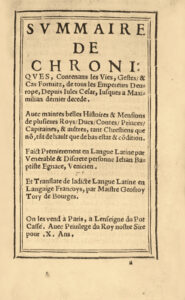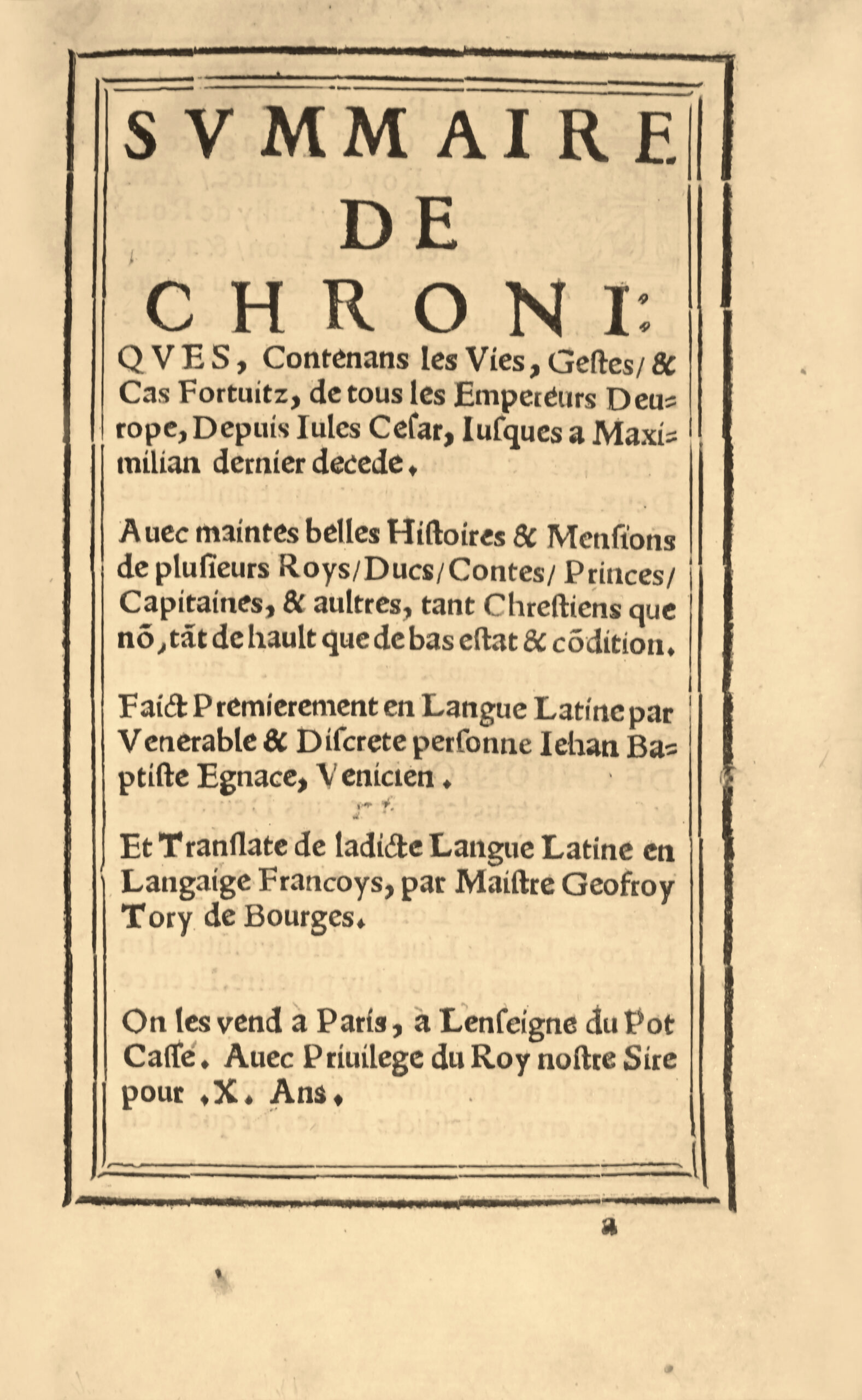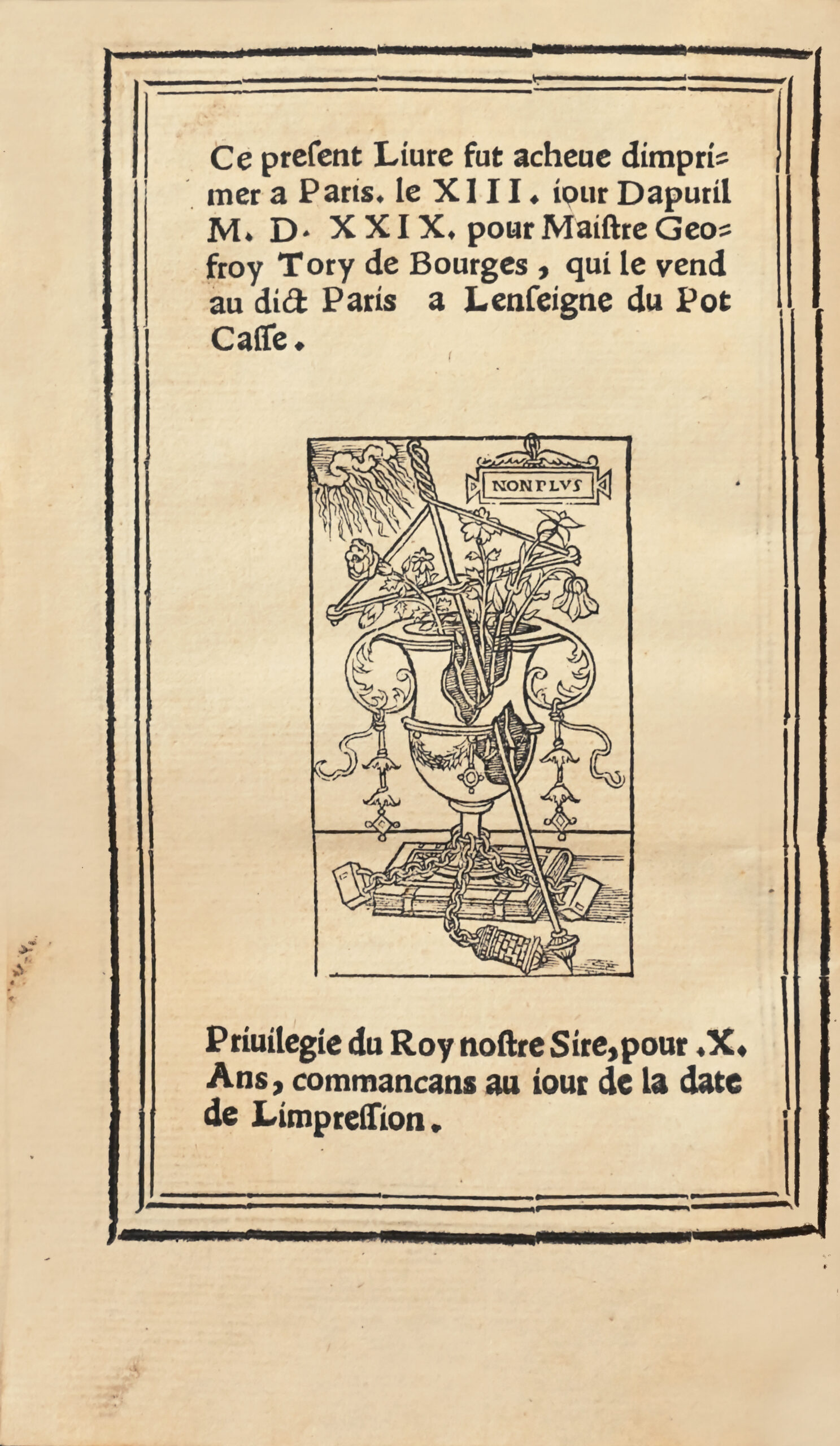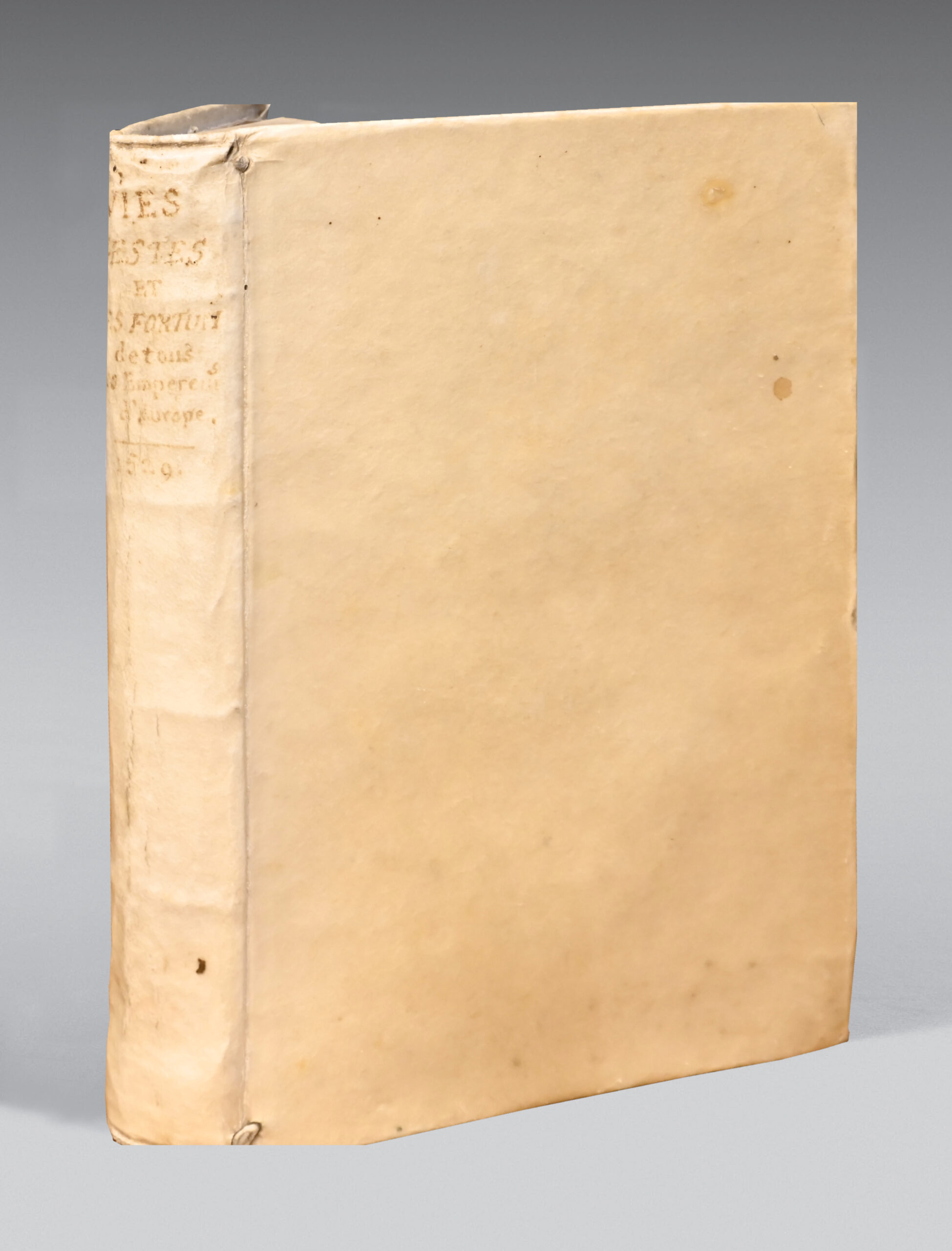On les vend a Paris, a Lenseigne du Pot cassé. (At the end) : Ce present Livre fust acheve dimprimer a Paris le XIII. Iour dapvril M.DXXIX, pour Maistre Geofroy Tory de Bourges, qui le vend au dict Paris a Lenseigne du Pot casse (13 april 1529).
Small 8vo, containing (16) preliminary ff., 99 text ff., and (13) table ff., round letters, mark of the broken pot on the last leaf, the entire text is printed within a triple filet frame.
Full ivory vellum, smooth spine, title and date calligraphed in brown ink, an infinitesimal worm track in the inner margin of about twenty ff. without affecting the text, ink stains on 2 ff., final guard renewed. Binding from the 17th century.
161 x 103 mm.
Precious and rare original edition of one of the only two French language books printed and translated by Geofroy Tory (1480-1533), the first printer to King Francis Ier, writer, engraver, and painter.
It was published fifteen days before Champfleury (April 28, 1529).” A very rare volume, of which Mr. Auguste Bernard (in his interesting research on Geofroy Tory) notes only one other copy in the library of Mr. Ambr. Firmin Didot.” (J. Techener. Cat. Felix Solar. Paris, 1860).
” One of Tory’s rare productions” (A. Firmin Didot. Paris, 1878).
“The only copy I have seen of this first edition, owned by Mr. Ambroise Firmin Didot…” (Auguste Bernard. Bibliography of Geofroy Tory – Paris, 1865).
“Rare volume, a copy of which bound in red morocco by Trautz-Bauzonnet sold for 142 fr. F OR. Solar, which is an exorbitant price ” (Brunet). At the same auction Solar (Paris, 1860), the fine copy of the first edition of Champfleury by the same Geofroy Tory, Paris, 1529, was sold for 152 F OR (currently valued at over 100,000 €). No. 613 of the catalog Solar.
“Geofroy Tory, from Bourges, to whom Mr. Aug. Bernard dedicated an excellent monograph (see column 898 of this volume), became famous for more than one reason… However, despite their real merit, this artist’s admirable productions seemed to have been almost generally unrecognized; and it is only in our days that they have been properly appreciated. Nowadays, collectors seek them with great eagerness and pay, so to speak, by the weight of gold“. (Brunet, year 1865).
” Geofroy Tory, this great artist who seems to have been universal, like the men of genius of his time, was versed in Greek, Latin, and even Hebrew literature. He was one of the most zealous promoters of the French language, whose spelling he reformed. He left teaching to learn the art of printing, which he later set rules for.
His talents as an artist, writer, and typographer earned him from Francis Ier (in 1529) the title of royal printer, a title that was then passed on to Néobar for Greek, to Robert and to Charles Estienne for Latin and Hebrew, to Olivier Mallard, Tory’s successor, for French, and to Denys Janot for the same language” (A. Firmin Didot).
Geofroy Tory also became famous for his “Champfleury” published the same year in 1529, a work infinitely less rare than the one studied here. His Books of Hours are particularly sought after; but only two works saw the light for which Tory was both printer and translator and thus, in the conception of the 16thè century, author: the present volume, printed in 1529, and “Plutarch’s Politics” printed in 1532.
In the epistle printed at the front of the volume, Geofroy Tory writes in the form of a preface.Geofroy Tory of Bourges to all studious and true lovers of honest reading
and fruitful pastime humbly says and gives greeting.I had promised you recently, in the preface to the Table of Cebes and the Thirty new dialogues of Lucian, that shortly from my little labors I would make you some other new book, which in my opinion might give you some good and graceful entertainment, in having fun reading and seeing things from which your spirit might in time and place be recreated and sweetly comforted. This time (my very honorable lords), as your humble servant, totally dedicated to you, I present to you a Summary of Chronicles, which I have translated for you, as the aforementioned Cebes and Dialogues, from Latin into French, as well as I could, advising you that, following the manner of Jehan Baptiste Egnace, present author, I have not moved: nor changed the sense of the history in favor of any man. My translation is also not word for word, because that would have been too dry a style and without any grace. I know, according to Horace, that (nec verbo verbum curabit reddere fidus interpres) a translator should not worry about rendering or addressing each word of what he translates to another word of his language; but must maintain the meaning, and express it in the most beautiful style possible. Thus I have done the best I could, both for the love and honor I owe you, and so as not to stray from the pure truth of the history, which is of such a nature, that it does not want to be alienated from its purity. Marcus Tullius Cicero taught us well, when he left us written, in the second book of his Orator, where he said: « Nam quis nescit primam esse historiae legem, ne quid falsi dicere audeat, deinde ne quid veri non audeat, ne qua suspitio gratiae sit in scribendo, ne qua simulatis ? » But who says he does not know that the first law of history is not to dare to speak falsehood, and not to feign to tell the truth, so that there is no suspicion of favor or envy in what is written? Surely history must be purely true, both for the already stated reasons, and because, as the said Cicero recited a little before the already cited place: « Historia est testis temporum, lux veritatis, vita memoriae, magistra vitae, et nuncia vetustatis.» History, he says, is a witness of times, a light of truth, the nurse and life of memory, the teacher and master of school to our life, and a messenger of antiquity. I would rather have chosen to present you with a history, and that in summary, than with something else, so that in enjoying it you can see, like in a mirror, a thousand excellent things, from which you can know and understand countless good lessons to occasionally serve you in time and place. Titus Livy said, in the preface of the first book of his first Decade « Hoc illud est precipue in cognitione rerum salubre ac frugiferum, omnis te exempli documenta in illustri posita monumento intueri, unde tibi tuaeque Reipublicae quod imitare cupias, unde foedum inceptum, foedum exitu quod vites. This, he says, is especially good and fruitful in the knowledge of things, to see and know in noble history the teachings of every example, through imitation and resemblance of which you can choose for yourself and for your republic what you should imitate and follow, and what you should avoid as an abominable case, both at the beginning and at the end. So please kindly accept this small work, and receive it with friendly face and aspect, as you have in good custom by your benevolence, and you will invite me, by your honest and singular grace, henceforth to do better, with the help of Our Lord Jesus, whom I pray to give you all his love and holy grace, for your noble and good desire.
From Paris, this 10th day of April M. D. XXIX. (April 10, 1529).
At the last leaf of the book, one sees the Pot Cassé, with the following inscription:
This first book was completed printing in Paris, the 13th day of April M.D.XXIX, for Master Geofroy Tory of Bourges, who sells it in said Paris, at the sign of the Pot Cassé.Rarity: only three copies on the public market since 1960:– a damaged calf copy sold for £5,500 by Sotheby’s on November 27, 1986, 39 years ago (“one very small wormhole in the final 28 leaves only affecting a very few letters, contemporary rough calf, spine slightly wormed”),
– “Abrams copy” with 28 leaves affected by a wormhole, a redhibitory defect for bibliophiles, however auctioned for $11,000 on November 17, 1989, 36 years ago,
– a 19th century vellum copy with many restorations sold by Bonhams for £5,000 on October 2, 2012, 13 years ago (“e nineteenth-century vellum, skillful repairs to first two leaves, with part of border made good, minor repairs at end“, catalogued and sold by a renowned bookseller a few months later at the price of €25,000.
Two complete copies in American libraries:.; .;(bound in the 20th (bound in the 20th century by Honnelaître).è Complete literary rarity, well preserved in its beautiful 17th century vellum, of one of the most beautiful typographic feats of the Renaissance.Reference: BMC: 7. 1234. 85.e siècle, de l’une des plus belles prouesses typographiques de la Renaissance.
Référence : BMC : 7. 1234. 85.



